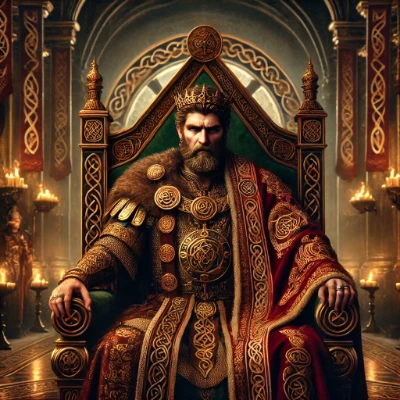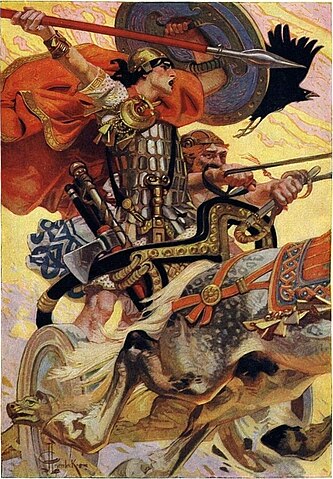Why Bricriu’s Feast Still Matters
Irish mythology has fascinating stories of heroes, feuds, and magical events. Bricriu’s Feast is one such story from the Ulster Cycle, a group of tales that focus on the adventures of Ulster’s legendary warriors. What makes Bricriu’s Feast so memorable is how it blends heroism with trickery, showing how easily pride and ambition can lead even the strongest individuals into conflict. In this post, we’ll explore the main points of this lively tale and discover what makes it stand out in Irish legend.
Table of Contents
Who Is Bricriu?
At the heart of this story is Bricriu, sometimes known as “Bricriu of the Poison Tongue.” He is a classic trickster figure who loves to stir up trouble amongst the warriors of Ulster. His method is simple: he flatters the heroes, plays on their desire for glory, and watches as they argue and compete. Bricriu’s cunning words are often more dangerous than any weapon the heroes wield.
The Feast at Bricriu’s Hall

Bricriu decides to throw a grand feast in his newly built hall. He invites all the important figures of Ulster, including:
- Conchobar mac Nessa, the King of Ulster
- Cú Chulainn, considered the greatest hero of Ulster
- Conall Cernach and Lóegaire Búadach, two other notable warriors
Although it’s presented as a celebration, Bricriu’s true aim is to watch these mighty warriors turn against one another in a contest of strength and honour.
The Champion’s Portion: A Catalyst for Rivalry
In ancient Irish heroic tradition, the “champion’s portion” is the best cut of meat, reserved for the bravest and most accomplished warrior at the feast. Knowing this, Bricriu secretly promises this honour to several different heroes before the celebration begins. Naturally, each warrior believes he deserves the champion’s portion. As soon as the feast starts, tensions rise as Cú Chulainn, Conall Cernach, and Lóegaire Búadach all vie for the prized cut.
Trials and Tests
Physical Feats
The warriors embark on a series of challenges to settle who deserves the champion’s portion. They demonstrate their skill with weapons, their strength, and their speed.
The Beheading Game
In one version of the story, a mysterious challenger appears and allows himself to be beheaded. He magically reattaches his head and then tests whether the warriors are brave enough to suffer the same fate in return—an early example of a motif also seen in tales like Sir Gawain and the Green Knight.
Seeking External Judgement
The Ulstermen can’t agree on the rightful champion even with these contests. They decide to visit other influential figures, such as Cú Roí mac Dáire, to settle the matter. Despite all attempts to give the other warriors a chance, Cú Chulainn often comes out on top, proving his exceptional skills repeatedly.
The Resolution: Cú Chulainn’s Triumph

Ultimately, Cú Chulainn’s unmatched bravery, speed, and martial prowess set him apart from the other heroes. He is the son of the god Lugh, which adds a hint of divine favour to his victories. Although Conall Cernach and Lóegaire Búadach fought well, Cú Chulainn repeatedly proved he deserved the champion’s portion. Bricriu, of course, gets exactly what he wanted—a fierce competition that leaves everyone talking about his feast.
Themes and Significance
- Trickster Archetype: Bricriu personifies the troublemaker who provokes heroes and exposes their weaknesses.
- Heroic Rivalry: This story shows how the heroes’ pride and ambition can lead them into conflict.
- Shared Motifs: The “beheading game” connects this Irish tale to other Celtic and medieval traditions, showing how stories circulate and evolve across cultures.
- Moral Lessons: On one level, Bricriu’s Feast is a warning about how easily vanity and envy can be manipulated.
Modern Reflections and Conclusion
If we look beneath the surface of this exciting myth, we see a timeless cautionary tale. Even modern audiences can relate to rivalries and the desire to stand out from the crowd. Just like the warriors of Ulster, people today can be lured into conflicts by flattery and a thirst for recognition. Bricriu’s feast reminds us that no matter how strong or skilled we are, we can still be deceived by sweet words and ambitions.
For those who want to explore more of Ireland’s mythological heritage, the Ulster Cycle offers a wealth of stories about heroes like Cú Chulainn and the often turbulent world they inhabit. Bricriu’s feast is just one example of how these ancient tales still speak to us, showing the heights of courage and the pitfalls of unchecked pride.
Book Recommendations:
- Gods and Fighting Men by Lady Augusta Gregory (1904)
- Early Irish Myths and Sagas, translated by Jeffery Gantz (Penguin Classics)
- A Dictionary of Celtic Mythology by James MacKillop (Oxford University Press)
